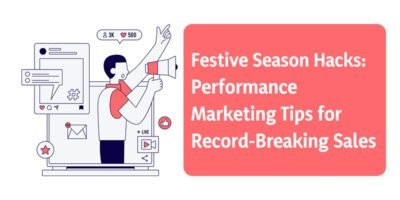Understanding the Key Metrics of Performance Marketing: CTR, CPA, and ROI
In the fast-paced world of digital marketing, understanding and tracking key metrics is essential for success. Performance marketing relies on data-driven insights to optimize campaigns and drive results. In this blog, we will explore three vital metrics: Click-Through Rate (CTR), Cost Per Acquisition (CPA), and Return on Investment (ROI). Let’s dive in and uncover the secrets behind these performance marketing metrics.
Click-Through Rate (CTR)
Click-Through Rate (CTR) is a metric used in digital marketing to measure the percentage of people who click on a specific ad or link after seeing it. It is a vital metric because it indicates the effectiveness of your advertising campaign and how well your ad resonates with your target audience. A high CTR suggests that your ad is compelling and engaging, attracting users to take action and click through to your website or landing page.
Factors Influencing CTR:
- Ad Positioning: The placement of your ad on a webpage or search engine results page can significantly impact CTR. Ads placed in prominent positions, such as at the top of a page or above the fold, tend to attract more attention and generate higher CTRs.
- Ad Relevance: The relevance of your ad to the user’s search query or the content on the webpage plays a crucial role in CTR. When your ad aligns closely with what users are looking for, they are more likely to click on it. Targeting the right keywords and creating ad campaigns that are relevant to your audience’s needs and interests can boost CTR.
- Ad Copy and Design: The wording, messaging, and visual elements of your ad significantly impact CTR. Compelling ad copy that effectively communicates the value proposition and creates a sense of urgency can drive higher click-through rates. Similarly, using eye-catching visuals, such as relevant images or videos, can capture the user’s attention and increase the likelihood of clicks.
How to Calculate CTR: Calculating CTR is relatively simple. Divide the number of clicks your ad receives by the number of impressions (the number of times your ad is shown) and multiply the result by 100 to get the CTR percentage.
CTR = (Clicks / Impressions) x 100
For example, if your ad receives 100 clicks and has 1,000 impressions, the CTR would be (100 / 1,000) x 100 = 10%.
Monitoring and analyzing your CTR regularly allows you to gauge the performance of your ad campaigns, identify areas for improvement, and optimize your marketing efforts to increase click-through rates.
Cost Per Acquisition (CPA)
Cost Per Acquisition (CPA) is a metric used in performance marketing to measure the cost incurred to acquire a single customer or lead. It calculates the average amount of money spent on marketing and advertising to generate a conversion. CPA is a crucial metric because it directly impacts the profitability and efficiency of your marketing campaigns. By understanding and optimizing your CPA, you can ensure that your customer acquisition costs align with your business goals and maximize your return on investment.
Calculation of CPA: To calculate CPA, divide the total advertising costs by the number of conversions generated within a specific period. The formula is as follows:
CPA = Total Advertising Costs / Number of Conversions
For example, if you spent $1,000 on advertising and obtained 50 conversions, your CPA would be $1,000 / 50 = $20.
Factors Affecting CPA: Several factors influence the CPA of your marketing campaigns:
- Conversion Rate: The conversion rate measures the percentage of users who take the desired action, such as making a purchase or filling out a lead form. A higher conversion rate means you are acquiring more customers with the same advertising spend, leading to a lower CPA.
- Average Order Value: The average order value represents the average amount of revenue generated from each customer transaction. A higher average order value allows you to offset your advertising costs, resulting in a lower CPA.
- Advertising Costs: The amount of money spent on advertising directly impacts your CPA. Higher advertising costs without a proportional increase in conversions can drive up your CPA. Therefore, it is essential to optimize your advertising campaigns, allocate your budget efficiently, and explore cost-effective advertising channels.
By focusing on improving the conversion rate, increasing the average order value, and managing your advertising costs, you can effectively reduce your CPA and enhance the profitability of your marketing campaigns.
Return on Investment (ROI)
Return on Investment (ROI) is a critical metric used to evaluate the profitability and effectiveness of marketing campaigns. It measures the return or profit generated concerning the amount of money invested. ROI provides insights into the financial performance of your marketing efforts and helps determine if your investments are yielding positive results. A positive ROI indicates that your marketing activities are generating more revenue than the costs incurred, while a negative ROI suggests the need for adjustments to improve profitability.
ROI Calculation Methods:
- Simple ROI Formula: The simple ROI formula calculates the return on investment by subtracting the cost of investment from the total revenue generated and dividing it by the cost of investment. The formula is as follows:
ROI = (Revenue – Cost of Investment) / Cost of Investment
- ROI with Attribution Modeling: Attribution modeling assigns credit to different marketing channels or touchpoints that contribute to a conversion. By considering the impact of various touchpoints in the customer journey, attribution modeling provides a more comprehensive understanding of ROI. It helps allocate credit proportionally to each channel involved in the conversion process, enabling a more accurate measurement of ROI.
Factors Influencing ROI: Several factors influence ROI and should be considered when analyzing marketing performance:
- Advertising Costs: The amount of money invested in marketing and advertising activities directly affects ROI. Higher advertising costs can reduce ROI unless they are justified by a corresponding increase in revenue or improved efficiency.
- Revenue Generated: The revenue generated from your marketing efforts plays a crucial role in determining ROI. Higher sales or conversions resulting from marketing campaigns contribute to a positive ROI, while low sales can impact ROI negatively.
- Timeframe of Measurement: The timeframe over which you measure ROI impacts the results. Marketing efforts often take time to generate results, especially in long-term campaigns. Consider the appropriate timeframe for ROI measurement based on your industry, campaign objectives, and customer buying cycle.
To maximize ROI, consider targeting high-converting keywords, optimizing landing pages for better conversions, and implementing retargeting and remarketing campaigns. These strategies can enhance the revenue generated from your marketing efforts while managing advertising costs effectively.
In conclusion, understanding the key metrics of performance marketing, such as CTR, CPA, and ROI, is vital for effective campaign optimization. Monitoring and optimizing these metrics regularly can lead to improved campaign performance, increased customer acquisition, and better returns on your marketing investments. Embrace these performance marketing metrics, adapt your strategies accordingly, and unlock the full potential of your digital marketing efforts.
Performance marketing is a powerful and effective way to reach potential customers and drive revenue for businesses in India. It is one approach that has gained popularity in recent years due to its effectiveness in delivering measurable results. In this blog, we’ll explore its benefits for your business and why you should consider implementing it into your marketing strategy.
What is Performance Marketing?
It is a digital marketing strategy that focuses on driving specific actions or goals such as sales, leads, or sign-ups. The primary objective is to deliver measurable results and track the return on investment (ROI) for each campaign. This is achieved by paying affiliates, publishers, or partners a commission for each successful action generated by their marketing efforts.
Benefits of Performance Marketing
- Cost-Effective: One of the most significant benefits of performance marketing is that it’s a cost-effective way to drive business results. Unlike traditional advertising methods, such as TV or radio ads, it only requires payment when a specific action is generated. This means you only pay for successful results, reducing the risk of wasting money on campaigns that don’t deliver results.
2. Measurable Results: Another significant benefit is that it’s highly measurable. You can track the performance of each campaign and see exactly how much you’re spending and the return on investment (ROI) for each campaign. This allows you to make informed decisions on which campaigns to continue and which to discontinue, ensuring you’re maximizing your marketing efforts.
- Targeted Marketing: It allows you to target specific audiences based on their interests, behaviors, and demographics. This means you can tailor your marketing campaigns to reach the right people at the right time, increasing the chances of success. By targeting specific audiences, you can also reduce the cost of acquiring new customers, improving your ROI.
- Flexibility: It is flexible, allowing you to adapt and adjust your campaigns based on performance. If a campaign isn’t delivering the desired results, you can make changes to optimize it, such as adjusting the targeting or creative. This means you can continuously improve your campaigns and maximize your marketing efforts.
- Brand Awareness: It can also help increase brand awareness. By partnering with affiliates or publishers, you can reach new audiences that may not have been aware of your brand before. This can help to increase brand awareness, drive traffic to your website, and ultimately, increase sales.
- Scalability: It is scalable, allowing you to increase your marketing efforts as your business grows. As you see positive results from your campaigns, you can increase your budget and expand your reach, driving even more successful results.
Examples of Performance Marketing
- Performance marketing can take many forms, including affiliate marketing, influencer marketing, and paid search advertising. Here are some examples in action:
- Affiliate Marketing: An e-commerce retailer partners with an affiliate network to promote their products to a new audience. The affiliate network earns a commission for each sale generated from its marketing efforts.
- Influencer Marketing: A fashion brand partners with an influencer to promote their new clothing line on social media. The influencer earns a commission for each sale generated from their unique referral link.
- Paid Search Advertising: A software company uses Google Ads to promote its new product. They only pay when someone clicks on their ad and lands on their website.
Performance marketing is a powerful marketing strategy that can deliver significant results for your business. By focusing on measurable results, targeted marketing, and scalability, you can increase your ROI and grow your business. If you’re looking to take your marketing efforts to the next level, performance marketing is worth considering.




